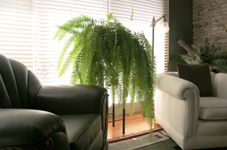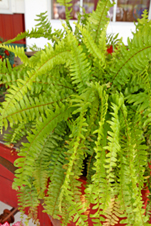Boston Ferns: Arching Tropical Elegance
These popular ferns add interest, texture, and graceful beauty indoors as exotic house plants, as well as outdoors in the garden or landscape.
Nephrolepis Exaltata belongs to the Davalliaceae family, and can be planted year round in USDA hardiness zones 8B through 11. When displayed outdoors in a hanging basket or container, this plant can be brought indoors during the winter.
Boston ferns can grow up to four feet tall, and, under ideal conditions, have the potential to become invasive. Their long, dramatic fronds grow up to three feet long and emerge from stems called rhizomes.
The semi-evergreen leaflets are an ovate shape, and can reach 2 to 4 inches in length. These ferns can be grown in containers, or planted outside as a tropical accent or ground cover in the garden or landscape.
Boston Fern Care - Indoors
Nephrolepis Exaltata are the perfect plants to display in hanging baskets, or in containers on pedestals. They need a little extra attention than other house plants, but with proper care, this plant can thrive and flourish.Tips for Houseplant Care
Lighting -
Choose a location that receives bright, indirect light. If leaves begin
to wither, the plant might not be receiving enough light.
leaves begin
to wither, the plant might not be receiving enough light. Temperature – The ideal daytime temperature ranges from 65°-75° F. Evening temperature should not fall below 55° F. Keep fern away from hot or cold drafts.
Humidity - These plants love high humidity. To provide adequate humidity, spray ferns with water on a daily basis, place plant container on a saucer filled with pebbles and water (water should be just below the pebble level), or run a humidifier in the room where your fern is located.
Soil & Fertilizer – You can use a regular potting soil with peat added into the mix. In spring and summer (during growing period), fertilize once a month with a liquid fertilizer diluted to ½ strength.
Watering – Keep fern evenly moist (not soaked) during spring and summer. During cold months, when growth slows, allow the surface of the soil to become slightly dry before watering.
Note: Groom regularly by removing dead or dying fronds.
Tips for Propagating and Potting
Boston ferns are easily propagated by plant division. The best time for
division is the spring. - If propagating, when potted fern becomes root bound, divide
 the root ball into smaller sections. If repotting, gently remove the
plant from the container. Loosen the roots if they seem tight.
the root ball into smaller sections. If repotting, gently remove the
plant from the container. Loosen the roots if they seem tight.
- Choose a container with good drainage. The larger the
container you choose, the larger the fern will grow.
- Fill the pot with several inches of potting soil. If you’d
like you can use two parts packaged potting soil, two parts peat moss,
and one part perlite.
- Place the fern in the center of the container. Hold the
plant upright as you add soil around the plant. Gently press the soil
around the edges of the fern.
- Water the plant so that the water runs out of the drainage hole.
Boston Fern Care - Outdoors
Boston ferns thrive in tropical and sub-tropical climates, and
can be planted year round in USDA Hardiness Zones 8B-11. They can be planted
outdoors in a container, used as a border, or mass planted as ground
cover.
When planted outdoors, Boston ferns have the potential to become
invasive – consider confining them with an edging or border.
Planting Tips and Outdoor Care
- Be sure you choose a bright, shady location that does not
receive direct sunlight.
- Allow 24 to 36 inches between plantings.
- Dig a hole twice the size of the root ball. Place the fern
in the hole, and fill the hole with garden soil. Water the fern during
the planting process to prevent air pockets.
- Water fern daily for a week after planting to establish
root growth. Keep soil moist during growing season.





